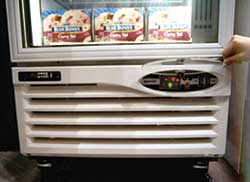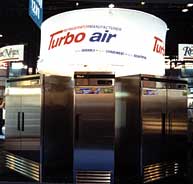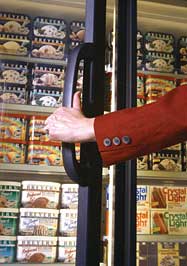
Manufacturers are continuing to search for more reliable ways to prevent the condensation/fog problem, in part so contractors can cultivate their more manageable and profitable service business.
Exhibitors at the Food Marketing Institute (FMI) and National Restaurant Association (NRA) expos showcased some of the newest trends in glass door units.
Master-Bilt (www.master-bilt.com) met the challenge of glass door freezers by using 2-inch-thick, foamed-in-place urethane insulation; a rear-wall guard for air circulation; triple-pane glass; and an electronic controller with demand defrost in its BGF-23 glass door merchandiser. The product was shown at the NRA show.
The electronic controller, which can be used with refrigerators as well as freezers, was created to replace a number of standard mechanical parts, the company said. The controller is designed to replace a room thermostat, de-frost timer, defrost termination/
fan delay control, and temperature indicator. The controller monitors temperatures and has a cyclical reset feature for the compressor, defrost system, evaporator, and fan.
Bill Huffman, Master-Bilt vice president of sales and marketing, said, "Traditional refrigeration systems are preset to defrost at certain times during the day, regardless of the amount of frost buildup on the evaporator. Frost accumulation, however, is not always consistent. It is influenced by changeable conditions like ambient temperature, humidity, and product load.
"Master-Bilt's demand de-frost feature offers an efficient alternative to the conventional method. Demand defrost constantly checks for the buildup of ice on an evaporator to determine if defrosting is required."
The design added a reverse-cycle valve to the condensing unit, to reverse the direction of refrigerant flow during defrosts. This method is designed to use less energy than electric defrost heaters. In fact, it is said to eliminate the need for such heaters, as well as head pressure controls, check valves, and expansion valves.
The company's CCG Series exemplifies the latest in glass-door reach-in refrigeration technology. The one- and two-door units have double-pane glass doors with heat-reflecting film and anti-condensate heaters in the door frame. The bottom-mounted refrigeration system uses R-134a.
Another method of fog reduction involves the use of a permanent treatment applied at the factory to the inside of the glass on reach-in doors. At FMI, Hussmann Corp. (www.hussmann.com) said its Always*Clear "is less costly than traditional anti-fog solutions."
At the FMI booth of Kysor/Warren (www.kysor.com), the company showed a three-door reach-in case with curved doors for use as end caps on case line-ups. The doors use what the company calls energy-efficient triple-pane glass, with 18 percent more glass than standard doors.
Still other companies opted away from triple-pane glass because of what they consider weight-related concerns. For example, Blue Air (www.blueairinc.com) used a double-pane door system with a layer of transparent, thermal insulation film applied between the layers of glass.

Solid Door Reach-Ins
In reach-ins with solid doors, energy efficiency is getting in-creased attention. Kolpak (www.kolpak.com) touted "a balanced refrigeration system with an HACCP [Hazard Analysis of Critical Control Points] monitor control with internal time clock, 72-hour storage, visual and audible alarms, and temperature monitors."A Windrunner Ductâ„¢ helps maintain a constant cabinet temperature regardless of load levels in high-demand conditions. Refrigeration controls are positioned for technician access, but designed in such a way as to limit unauthorized adjustments, the company said. The electronic control touch pad allows for incremental adjustments.
The S-Series marks Kolpak's entry into the reach-in arena. It mirrors the Simplicity-Savings-Sanitation-Serviceability marketing approach of Manitowoc S-Series ice machines. (Kolpak is part of the Manitowoc Foodservice Group.)
Top-mounted refrigeration systems are becoming more common in reach-in units, to provide storage area cooling with a minimum of refrigeration components inside the cabinet, allowing more space for product.
Maximizing operating costs is done through "compressor systems sized correctly," explained Bill Keske, vice president of marketing for Delfield (www.delfield.com). This company introduced the 6000XL reach-in.
"It was important for us to design a reach-in for the foodservice professional," Keske said. "We took into consideration all the features they require, such as more internal storage capacity, ease of cleaning and use, and constant cooling for safe product temperature."
A technology called XStream® was featured at the NRA booth of Carrier's Beverage Air (www.beverage-air.com). A specially designed valve sprays a thin and uniform coating of refrigerant on all interior surfaces of the evaporator tubing. This increases cooling capacity and better maintains temperature and humidity in both glass and solid door units, the company said.
In addition, the product offers stainless steel panel construction inside and out to increase temperature stability. Doors are reinforced with 2 inches of foamed-in-place polyurethane.
Beer dispensers, refrigerators, and refrigeration equipment for wine cellars were shown by Summit (www.summitappliance.com), including a formulation of three drawers within a refrigerator cabinet.
Compact models from Sanyo North America Commercial Foodservice Equipment were displayed by Asbury Management (www.asburymanagement.com). IMI Cornelius (www.cornelius.com) had single-door reach-ins with external monitor control panels. Turbo Air, showing through ARC Distributors in Bensenville, Ill., featured multidoor units with a high-efficiency evaporator and airflow through wide spaces between the fins. And Northland Refrigeration (www.northlandnka.com) offered units with dual fans for increased air circulation.
Hoshizaki's (www.hoshizaki.com) Evercheckâ„¢ control system and coil coating is said to control and extend the life of under-counter refrigerators and freezers. A cassette-style refrigeration system can be removed for servicing.

Having A Blast
Blast chilling technology quickly reduces the temperature of hot foods to prevent bacterial growth. According to Food and Drug Administration recommendations, foodservice operators have about 2 hours to reduce the temperature of hot food to 70 degrees F, and another 4 hours to decrease it to 40 degrees, to suspend bacteria growth.That's just the government's criteria. Store owners need to increase shelf life by two or three days, and the buying public requires food that tastes good after reheating.
All those factors enter into blast technology. Master-Bilt showed a prototype roll-in blast chiller at the NRA show. The product represents a new direction for the company, which has been making commercial refrigeration systems for 65 years.
The Master-Chill MCR Series has stainless steel construction with polyurethane, foamed-in-place insulation. A flush-mounted exterior control panel has a digital readout of the interior ambient temperature. A digital cycle timer automates defrost and hold cycles. An audible alarm sounds once chilling ceases.
"The blast chiller is one of the most sensible products to bring to the market," said Master-Bilt's Huffman. "We wanted to supply our customers with a solid, reliable product."
Blast chiller technology can en-compass a range of sizes and configurations, such as under-counter, reach-in, and roll-in. The VBC-70 under-counter model from Victory Refrigeration (www.victory-refrig.com) was shown at the NRA show.
It can process up to 70 pounds of food product in a 90-minute cycle, according to the company. It reverts to automatic storage mode at the end of each cycle and, in effect, becomes a more typical 38 degrees refrigerator, the company said. It has a three-step control panel, built-in printer for recordkeeping, and three food probes.
Walk Right In
Bally Refrigerated Boxes (www.ballyrefboxes.com) used the Pro3® system, a pre-piped and -wired packaged unit that is designed to drop into a factory-cut opening in a ceiling panel.There is a mix-and-match aspect when a line of walk-in coolers and freezers - like those from Elliott-Williams (www.elliott-williams.com) - can integrate with multiple refrigeration units.
People who make decisions about walk-in purchases need to realize that such units are often placed outside. They need to consider wear from sun, rain, snow, and saltwater.
One end user told representatives from Polar King International Inc. (www.polarking.com) that he needed a cooler that could withstand 95 degree to 100 degree summers and 70- to 100-percent relative humidity. The employees stressed the value of a seamless fiberglass exterior to prevent leaks and rust.
Decision makers are told to pay as much attention to doors, right down to gaskets and overall weight, as they would insulation and refrigeration.
Eliason (www.eliasoncorp.com) offered high-traffic doors that might get whacked by pallet jacks, dollies, and hand trucks; medium- to heavy-traffic doors where good looks are needed, such as when customers can see them; light- to medium-traffic doors that might be used in convenience stores, retail outlets, or department stores; cooler doors where there is a temperature differential of 10 degrees to 30 degrees; and foodservice doors used in restaurants and sports bars, where durability and good looks seem to have almost equal importance.
If you are involved in specifying such products, here's a word to the wise: Do your homework.
Sidebar: FMI, NRA Coverage In The News
This is the second of three articles covering the latest in refrigeration-related technology showcased at two major trade shows that took place this past spring: the Food Marketing Institute (FMI) Expo and the National Restaurant Association (NRA) show. The article in the July 5Newsfeatured ice machines and related technology. This article features reach-in and walk-in coolers and freezers. The Sept. 6 article will focus on supermarket refrigeration technology.Sidebar: Reach-In, Walk-In Market Moves
CHICAGO - Several new and noteworthy developments were announced in conjunction with the FMI and NRA shows. Hill Phoenix (www.hillphoenix.com) announced it is expanding production at its 100,000-square-foot manufacturing facility in Covington, Ga., where it makes National Coolerâ„¢ walk-in coolers and freezers for convenience stores and supermarkets. The company said it will double its manufacturing capacity at the plant. The company also makes National Cooler products in San Dimas, Calif.Victory Refrigeration (www.victory-refrig.com) launched a single-section, dual-temp warmer/refrigerator. The two-in-one unit is available as a single-section pass-through unit with the warmer on top, refrigerator on the bottom, or any other combination. The equipment is designed for use near a cashier station, according to the company. An insulated partition separates the two compartments.
The concept of rehabbing and reusing walk-in coolers and freezers was advanced at the FMI Expo by Barr Inc. (www.barrinc.com). The company buys used coolers and freezers in the 40- to 20,000-foot range and refrigeration systems from 2 to 200 hp. They are reconditioned by certified technicians at the company's facility in Oshkosh, Wis., according to the company, and are resold with a warranty.
At the National Association of Food Equipment Manufacturers (NAFEM) show in New Orleans, Master-Bilt announced it was looking for the oldest of its refrigeration systems still running. The winner was announced at the NRA expo.
George Hayden, owner of a Dairy Kastle soft serve ice cream parlor in Louisville, Ky., had two 30-plus-year-old milk coolers still running with the original gaskets, compressors, and motors. One of those original coolers will be replaced with a new piece of equipment at no charge. The second will remain as a backup unit.
Carrier Commercial Refrigeration (www.ccr.carrier.com) made an agreement with XDX Innovative Refrigeration (www.xdxusa.com) as the exclusive OEM for XDX's X-Stream® and A.R.M.E.D.® technologies, according to a statement from XDX.
The technologies' heat transfer processes differ from ordinary direct-expansion feed in several ways, XDX said. A special valve allows a thin coating of refrigerant to line the entire inside of the evaporator tubing, resulting in "a rapid removal of heat from the product or conditioned space," the company said; "temperatures improve, the system runs less, and equipment performs better in the controlled manner of refrigerant feed."
- Peter Powell
Publication date: 08/02/2004


Report Abusive Comment